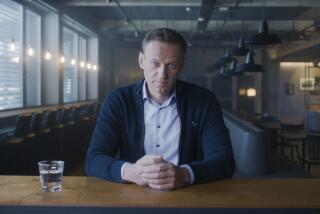A Thorough Look at Nureyev, Both the Man and the Dancer
- Share via
NUREYEV: His Life
by Diane Solway
William Morrow
$27.50, 625 pages
*
Nureyev. There are very few names--Heifetz, Picasso, perhaps--that conjure so immediately not just a body of work but an entire art. “Star” does not begin to describe the position Rudolf Nureyev held in the intersecting universes of ballet, politics and sex during the ‘60s, ‘70s and even into the ‘80s. And yet he was a latecomer to dance, a political naive. “What he lacked in technical polish,” noted one observer, “he more than made up for with a thrilling, authoritative performance that shattered the academic mold.” Rumor had it that such an opinion covered all three intersections.
That authority and how it played out on stages large and small is the subject of Diane Solway’s fascinating biography, “Nureyev: His Life.” Some readers may be drawn to Solway’s thorough record of Nureyev’s dance career, from his earliest studies in the outpost of Ufa, through his admission to the Leningrad Choreographic Institute and Kirov Ballet, his long tenure as a guest of England’s Royal Ballet and his autumnal dalliances with George Balanchine and Martha Graham. Others may be fascinated by her detailed and thrilling account of the days leading up to Nureyev’s 1961 defection in Paris’ Le Bourget airport, a story necessarily altered by Nureyev in his autobiography and only recently made available with the new declassification of Soviet documents.
But it is Nureyev the man, the strange son of a Soviet apparatchik who missed much of his son’s childhood while off defending Stalin’s motherland, who is Solway’s greatest creation. Solway writes with an authority earned in voluminous research and dozens of interviews with Nureyev’s surviving friends and colleagues. Although celebrities speckle the book, Solway focuses between the glitter to follow the major guides of Nureyev’s life, the people most important to him--Lee Radziwill, for example, who was devoted to him, rather than her sister, Jacqueline Kennedy, who was a more distant friend. Solway devotes several chapels to St. Margot Fonteyn, the unblemishable Queen Mother of ballet, in a portrait that describes very carefully Fonteyn’s exact partnership with Nureyev, while granting her a full life of her own that included 20 years of pre-Rudi stardom.
At the heart of the book is Nureyev’s 20-year relationship with his predecessor, lover and friend Erik Bruhn, the prince of Denmark. Bruhn, whose dignity and technical perfection were in tragic contrast to Nureyev’s blurry inspiration, comes across as a patient friend, feeding his hungry Tartar warrior years of classical technique and history, all the while recognizing that Nureyev’s star was destined to eclipse his own.
The story ends, of course, with Nureyev’s death from an AIDS he refused to acknowledge publicly. That refusal--held against him by many who believed his admission would help counter the shame associated with the disease--is fully in line with the unconscious sexuality that Nureyev brought to his life and his art. Unlike his rock doppelganger Mick Jagger (a big fan and sometimes friend), Nureyev drove his sexuality without forethought or meditation.
Jean-Paul Sartre wrote in his autobiographical “The Words” that he owed his lack of a superego to the death of his father while he was still in his mother’s womb. Perhaps that lack of a paternal superego was key to Nureyev’s technique as well. As one critic put it, “It is the James Dean charm of a boy who will always be in trouble and always forgiven.”
More to Read
Sign up for our Book Club newsletter
Get the latest news, events and more from the Los Angeles Times Book Club, and help us get L.A. reading and talking.
You may occasionally receive promotional content from the Los Angeles Times.










